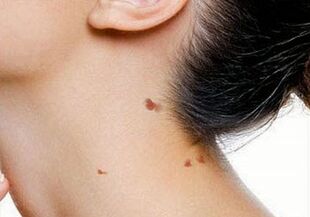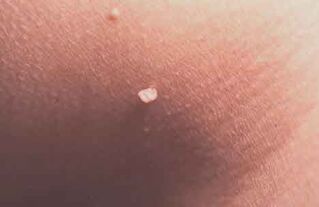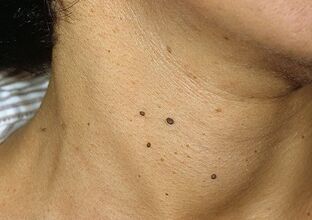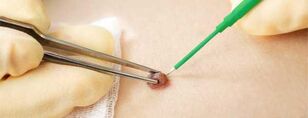
Papillomas on the neck (filamentous warts) are the result of infection with the human papilloma virus caused by swallowing or activating the human papilloma virus (HPV) that is already present in the cells. This site of localization of neoplasms is often found. Experts call such papillomas filiform warts (acrochord). They can appear not only on the neck, but also in the armpits, behind the ears, under the mammary glands.
Determining the cause and selecting methods for treating neck papillomas is the task of experts. Human papillomavirus infection is dangerous to health, it can lead to the growth of malignant tumors, especially in combination with genital warts and urogenital diseases.
Mechanism of disease development
Papilloma virus is found in most sexually mature people. HPV enters the body through damage, cracks, during massage, the use of other people's hygiene products, footwear, as well as unprotected sexual intercourse. For several months or even years, the papilloma virus does not manifest itself in any way, which indicates a chronic carrier. When viruses multiply in the surface layers of the skin, tissue hyperplasia occurs, filamentous protrusions appear on the neck and other parts of the body.
Important! HPV is not persistent in the environment. The virus dies quickly on household items. Infection mainly occurs through direct contact.
During shaving, manicure, self-infection is possible when the dormant virus is activated. The disease passes into the phase of active clinical manifestations, then hyperplastic processes appear in the skin.
Causes of neck papilloma

It is almost impossible to say exactly why papillomas appear on the neck. Experts identify the following predisposing factors:
- transmission of severe infectious diseases, surgical interventions that weaken the immune system, reduce the adaptive abilities of the body;
- frequent damage to the skin by clothing, hygiene and care products;
- performing massage with non-compliance with infectious safety techniques in low-quality salons by workers infected with HPV;
- hormonal disorders, endocrine pathologies;
- the presence of other types of papillomas, genital warts and warts on the body and genitals.
Experts believe that the causes of neck papillomas may be related to hormonal changes in the body. This confirms the fact that filamentous warts often appear after endocrine pathologies, during pregnancy and during menopause, when the activity of sex hormones decreases.
In young women, the cause of neck papillomas is often ovarian dysfunction. But initially HPV must be in an inactive form in the body. The hormone wave is just a provocative factor.
Clinical manifestations
Neck papillomas have virtually no clinical manifestations. On the outside they resemble small growths of a conical shape, yellowish or fleshy in color. Neoplasms have a fairly thick consistency. Their size rarely exceeds 6 mm. Most often, filamentous papillomas on the neck are found in small groups, can grow together and form foci that resemble sand or cauliflower in shape.
Papillomatous shoots of this type are not prone to magnetization, but if they are damaged, the risk of tissue malignancy remains. Neoplasms can become inflamed, often provoking the spread of the papilloma virus to healthy skin with the appearance of new warts.
Examination of neck papilloma
During an extensive examination, it is possible to determine the causes of neck papillomas and methods of treatment. When filamentous growths appear, you should consult a dermatologist.
Main diagnostic methods for papillomas of the neck, armpits and other parts of the body:

- PCR;
- dermatoscopy;
- neoplasm tissue biopsy;
- histological examination.
Papillomas on the neck are different from ordinary warts, fibroids, moles. The virus can be detected during a PCR study. This method allows you to identify the DNA of the virus, to assess the degree of oncogenicity of the formation and the amount of HPV. The most dangerous types of HPV are 16 and 18, which cause cervical cancer.
Papilloma tissue biopsy is performed if a malignant process is suspected. Chronic papilloma virus infection contributes to tissue hyperplasia and often leads to magnetization. That is why it is so important to detect viruses with a high oncogenic risk in a timely manner and to remove papillomatous growths.
Treatment Methods
The treatment regimen for neck papillomas is selected individually. This takes into account:
- number of neoplasms, their shape and size;
- general health of the patient;
- degree of risk of malignancy of neoplasms;
- presence of concomitant diseases, including external and internal tumors, urogenital infections.
To understand how to get rid of papillomas on the neck, the doctor prescribes a comprehensive examination, be sure to determine the type of HPV. Further tactics depend on it. Papillomas are the result of active virus replication and require antiviral therapy.
Therapeutic treatment
Medicines for human papilloma virus infection are used only after consultation with the attending physician. Such agents inhibit the further growth of HPV, prevent complications, including malignancy of the neoplasm.
Most often, experts prescribe a drug with antiviral action, which additionally has an immunomodulatory effect. It is extremely important, especially with frequent relapses, to increase the activity of the immune system in order to reduce the number of exacerbations per year.
Therapeutic treatment of human papillomavirus infection continues for several months. While taking the medication, monitoring of laboratory parameters, blood and urine donation, is recommended in order to detect an increase in the load on the liver and kidneys in time.
is recommended in order to detect an increase in the load on the liver and kidneys in time.
If for some reason specialists delay surgical treatment of warts on the neck, it is necessary to give up clothing that injures the tumor. With even less damage, the risk of spreading the papilloma virus to healthy areas of the body increases sharply.
In addition to antiviral drugs, you can use ready-made pharmaceutical products to remove papillomas. But this method of treatment is traumatic. With increasing oncogenic risk, it cannot be used.
Pharmacy papilloma removal products
Finished preparations for removing papillomas from the neck contain acids and aggressive components that destroy neoplasm cells. It is recommended to use such funds in accordance with the attached instructions and after consulting a doctor.
Basic principles of removing warts and papillomas with finished products:
- Before applying the topical preparation, healthy skin should be treated with zinc paste or vegetable oil;
- it is forbidden to use products for the treatment of children under 10-12 years and adults with sensitive skin and chronic allergic pathologies;
- Do not apply medication to moles.
If part of the medicine gets on healthy skin or mucous membranes during the use of papilloma remover, the skin should be washed immediately with running water and soap to neutralize acids and alkalis.
Common medications for papilloma removal:
- A drug in tablets, which belongs to anti-inflammatory and immunomodulatory agents. It reduces the amount of virus, which contributes to a gradual reduction in the size of the tumor. Combination with local treatment is recommended.
- A preparation used to freeze papillomas to the base. A slight burning and stinging sensation is felt during application of the product. The skin becomes white and then red with blistering. Complete tissue regeneration comes in 2-4 weeks.
- The application of the product is based on the cold effect on papillomas. Low temperature destroys neoplasms, causes serious disorders in metabolism and tissue nutrition, which leads to their death.
- Celandine products. Similar medications are used to remove neck papillomas at home. In addition to celandine juice, they contain other aggressive components, including alkalis. Before using the product, you must protect healthy skin with an oily cream, vegetable oil or zinc ointment.
Papilloma control pharmaceuticals are used in accordance with official instructions for use. Some medications have an aggressive composition that can cause inflammation, irritation, and even chemical tissue burns. With high skin sensitivity, such funds are contraindicated. It is better to use minimally invasive surgical methods to remove papillomas on the neck.
Surgical treatment
Surgical treatment of papillomas is the gold standard. All neoplasms that appear on the skin and mucous membranes in the background of human papilloma virus infection must be removed. No specialist can guarantee that sooner or later the neoplasm will not lead to magnetization and growth of the malignant tumor.
Main methods of surgical removal of neck papillomas:
- laser coagulation;
- cryodestruction;
- radio wave mode;
- electrocoagulation;
- surgical excision of the neoplasm using a scalpel.
The physician selects a specific papilloma removal method based on a comprehensive examination. Surgical excision of skin neoplasms is performed for large tumors and the risk of malignancy. In other cases, experts try to use minimally invasive techniques that do not leave scars and blemishes on the skin.
Laser coagulation

The laser effectively fights growths on the skin and mucous membranes. The method provides the most accurate and targeted effect on controlled tissue depth. There are no painful sensations during the procedure. Specialists usually use injection anesthesia or application anesthesia.
High-energy lasers evaporate viral neoplasms with highly targeted laser beams. In this case, there is a simultaneous coagulation of blood vessels. Exposure to high temperatures prevents the papilloma virus from spreading through the bloodstream to healthy areas of the skin.
A scab forms at the site of the destroyed papilloma, which disappears on its own after about a week. The slight redness of the skin remains for 2-3 months and then disappears completely.
Cryodestruction
Cryodestruction is based on the effect of cold on skin neoplasms. Liquid nitrogen freezes papillomas and leads to their destruction. The tissues then die off by forming a small crust.
During the procedure, the cytoplasmic and intercellular fluid freezes, the cellular structures of the papilloma are damaged, which makes the neoplasm unsustainable. Exposure to low temperatures stops lymph circulation and blood flow in the tissues of the papillomatous tumor.
During the application of liquid nitrogen, the skin becomes white, slightly swollen, and after the procedure reddens with the appearance of an inconspicuous blister. Complete tissue regeneration comes in a few weeks.
Papilloma removal by radio waves
The method of papilloma removal by radio waves is significant for its availability and moderate trauma. When radio frequency waves penetrate the skin, heat is released, with the help of which it is possible to remove tumors by evaporating cells. During the procedure, the tissues are separated, as if using a scalpel. The method is suitable for those who need histological analysis after surgical removal of the papilloma.
Electrocoagulation
Electrocoagulation is a modern method of papilloma removal. During the electrosurgical procedure, the doctor cuts off the stem of the tumor, and then burns the base of the tumor with an electric current. The method is more suitable for removing small papillomas, because the electrocoagulator has a small working loop size.
Important! Surgical treatments are combined with antiviral therapy and immunostimulatory agents.
The growth of neoplasms is associated with the activity of the immune system. Specialists pay special attention to increasing immunity both with the help of medication and with the use of safer methods (swimming, hardening, balneotherapy).
Traditional methods
Alternative treatments include topical papilloma removal medications and internal immune-boosting preparations. Echinacea has immunostimulating properties. Tincture from this plant with prolonged use increases the activity of the immune system and resistance to contact with virus carriers.
The most commonly used topical remedy is celandine juice. It is found on neoplasms several times a day. The duration of treatment is not longer than 5-7 days. The use of celandine juice to remove large papillomas is not recommended due to the high risk of burns. The product is not used on mucous and sensitive parts of the skin.
At home, you can try to remove small papillomatous growths on the neck with salicylic acid. The application of garlic can be used to stop the growth of HPV and reduce the risk of spreading the pathogen to healthy tissues. To do this, a few cloves of garlic are rubbed on the grater, and the resulting mass is applied to the skin neoplasms. This method should not be used for cuts and damage, as well as for the removal of papillomas on the mucosa.























